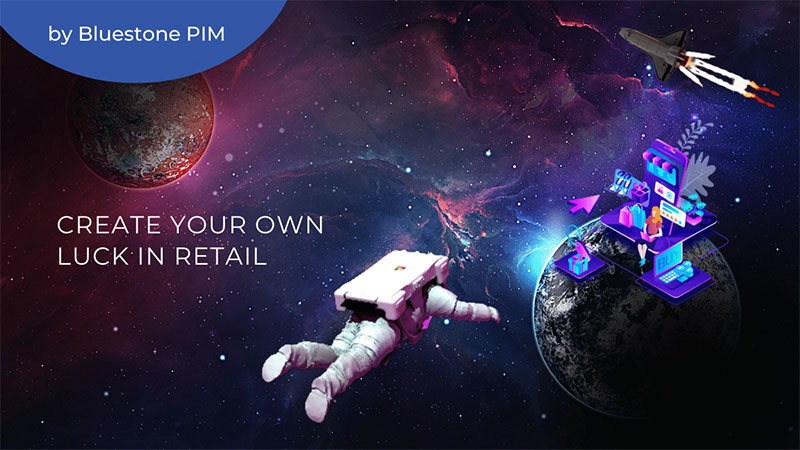5 Signs Your Business Needs a PIM Solution

Table of Contents
- Sign 1: You’re drowning in a sea of SKUs
- Sign 2: You want to have an easier time selling on multiple channels
- Sign 3: You spend too much time firefighting customer experience issues
- Sign 4: You want your business to go global
- Sign 5: You want AI-powered product data
- Take control of your product data with Bluestone PIM
“74% of companies claim that having a single PIM software solution allowed them to eliminate errors and mistakes in product information”
Source: Ventana Research
For retailers, manufacturers, and distributors, high-quality product information is a must. Customers expect detailed descriptions, clear specifications, and captivating visuals to make an informed buying decision. But managing this data, especially as your product catalogue grows, can quickly become a nightmare.
This is where a Product Information Management (PIM) solution comes in. A PIM system acts as a single source of truth for all your product data, streamlining workflows and ensuring consistency across all sales channels. But how do you know if your business has outgrown spreadsheets and needs a more robust solution?
Here are 5 signs you need a PIM solution:
Sign 1: You’re Drowning in a Sea of SKUs

Are you managing thousands of stock keeping units (SKUs)?
With a large and ever-growing product catalogue, juggling spreadsheets and siloed data becomes almost impossible. A PIM system allows you to centralise and categorise all your product information so it's easy to find and manage.
Small product portfolio? Spreadsheets might suffice. For businesses with less than 100 products, managing information with spreadsheets and templates is doable. However, if you plan to expand your product range, this can be a challenge.
Imagine updating thousands of product descriptions, attributes, and images manually. This process is often error-prone, time-consuming, and tedious. This is where a PIM system comes into play.
Instead of PIM, Can I Use MDM or ERP
While Enterprise Resource Planning (ERP) and Master Data Management (MDM) systems fulfil certain product data requirements, they are not ideally suited for centralised management, optimisation, and syndication of high-quality product information across all touchpoints.
If control over accurate, well-governed product information that reaches all audiences and stakeholders is a top priority, then a dedicated PIM system may be a better choice as it offers optimised capabilities for the complete management of product data throughout its lifecycle.
Focus on External Excellence
PIM is designed for external focus. It streamlines information management, ensures data quality, and empowers your marketing and sales teams to deliver exceptional product experiences across all channels.
Don't get stuck with a PIM system that can't keep up with growth. When choosing a PIM system, think about the future. Can the PIM system you choose handle a surge in SKUs or an explosion in website traffic? If you want a future-proof PIM system that can seamlessly scale to the needs of your business, you should opt for a cloud-based PIM system, as you can also easily import a million SKUs from your ERP or MDM system.
Sign 2: You Want to Have an Easier Time Selling on Multiple Channels

“73% of customers use multiple channels during their shopping journey”
Source: Harvard’s Business Review
If you actively sell on multiple platforms such as your own website, Amazon or social media marketplaces, keeping your product data synchronised becomes a major challenge. With a PIM system, this is no longer a problem, as it integrates your various sales channels and ensures that your product information is always up-to-date and consistent, eliminating the risk of errors.
Today's customers expect a seamless experience across all channels. But managing product content for each platform can be a nightmare. Different channels require different content, and data consistency is a major challenge.
PIM solves the omnichannel content puzzle.
Some of the key benefits of omnichannel marketing:
-
Customised content for each channel: Highlight the product features that resonate best with each target audience.
-
Ensure data consistency: Avoid errors and ensure correct information across all channels.
-
Save time and resources: Update product data once and let PIM automatically distribute it everywhere.
A seamless omnichannel strategy hinges on the consistent and accurate presentation of product information. PIM facilitates clear communication between departments and accelerates data enrichment for a consistent customer message.
It enables an effective exchange of information between internal teams. Customer service representatives are equipped with accurate product details, which allows them to provide better support. Live chat features supported by PIM further enhance the online customer experience. By setting up efficient workflows, PIM lays the foundation for a smooth customer journey and promotes brand loyalty.
In conjunction with Digital Asset Management (DAM), PIM enables organisations to communicate this information across all customer touchpoints. DAM ensures brand consistency by providing a central repository for all digital assets, whether they are product images, videos or other marketing materials. This comprehensive overview makes it easier to identify and eliminate inconsistencies and guarantees a consistent shopping experience across all channels.
Example: A sportswear company undergoing a rebrand can utilise DAM to efficiently access all necessary assets and ensure a smooth brand launch across all platforms. By combining PIM and DAM, your teams can develop a successful omnichannel marketing strategy that will drive future growth.
Sign 3: You Spend Too Much Time Firefighting Customer Experience Issues

Inconsistent or inaccurate product information leads to frustrated customers and lost sales. A PIM system ensures that your descriptions, specifications, and images are consistent and provides your customers with a seamless and trustworthy experience.
Here's how PIM contributes to an exceptional customer experience:
Consistent and Accurate Information
Imagine a customer is researching a new running shoe online. They find it on your brand’s website with detailed specifications and benefits. After switching to a different online marketplace, they find the same item — with a different description, size options and product images. These inconsistencies cause confusion. The PIM solves this problem by acting as a central hub for all product information, descriptions, categories and features.
Targeted Content for Different Channels
Social media platforms like Instagram thrive on visual storytelling. While a detailed technical description might work on your website, a captivating product video or lifestyle image might have more impact on social media. With PIM, you can tailor content to the strengths of each channel.
For example, a clothing brand could use PIM with integrated DAM functionality to manage a large collection of product images, but also use the system to create engaging social media posts that showcase different outfits and styles.
Faster Time-to-Market & New Product Launches
Staying ahead of trends and bringing new products to market quickly is crucial for customer engagement. PIM streamlines product information gathering and enrichment, allowing you to onboard new products with speed and efficiency.
This reduces waiting times for customers who are desperate to have the latest products.
Personalised Product Recommendations
Customers appreciate brands that understand their needs. PIM can be integrated into a CRM solution or marketing automation software so you can use product data to make personalised recommendations. By analysing past purchases and browsing behaviour, PIM can suggest complementary items to increase customer satisfaction and boost sales.
Example: An electronics retailer can use PIM data to recommend a case or screen protector for a smartphone purchase, creating a more convenient and personalised shopping experience.
Improved Search Functionality
Finding the right product quickly is paramount for a positive customer experience. PIM helps to categorise product data and enrich it with relevant keywords and attributes. This leads to a more robust search function on your website and online marketplaces, allowing customers to easily find the products they're looking for.
When you introduce a PIM solution, you're investing in a future-proof strategy for the customer experience in the omnichannel landscape. With PIM, you can provide accurate and engaging product information across all touchpoints.
Sign 4: You Want Your Business to Go Global

The allure of expanding into new markets is undeniable for global retailers. However, the complexity of international product data management can quickly become a significant hurdle.
Here's where a PIM system becomes helpful:
Localised Content for Global Audiences
Imagine launching a popular clothing line in Europe without taking metric conversions or regional size differences into account.
A PIM system overcomes these barriers by allowing you to:
-
Translate product descriptions: Ensure clear communication with your customers by translating product descriptions into their native language.
-
Customise dimensions and units: Take local preferences into account by converting product measurements (e.g. inches to centimetres) and adjusting units (e.g. pounds to kilogrammes) to match regional standards.
Example: A global sporting goods retailer uses PIM to manage product information for thousands of items in different categories. When launching a new line of fitness trackers in Japan, the PIM system automatically translates the product descriptions into Japanese, converts dollars into yen, and ensures that battery life is listed in hours instead of minutes — all while maintaining global brand consistency.
Considerations for Compliance with Rules and Regulations
The forthcoming European Union directive on the Digital Product Passport (DPP) heralds a new era of transparency. It requires a digital record to be created for a wide range of products, containing information on their environmental impact, material composition and life cycle.
Retailers need to adapt their operations to enable the collection and storage of this comprehensive data for each applicable product. PIM can help manage the complexity of DPP by allowing the enrichment of existing product data with DPP-specific details such as materials, origin and environmental footprint. PIM also ensures a standardised data format, facilitating integration into future DPP platforms.
PIM also facilitates the creation and management of DPPs for a wide range of products. It simplifies data collection and updating and enables retailers to comply with regulations efficiently.
Keep in mind that retailers operating in different countries need to consider and comply with different product information regulations.
A PIM system can help you comply with regulations by:
-
Managing regional variations: Store and manage product information specific to different regions, including legal disclaimers, safety warnings and ingredient lists translated into the local language.
-
Streamlining content updates: Easily update product information to reflect changes in regional regulations and ensure compliance in all markets.
Example: A major electronics retailer uses PIM to manage the safety warnings for their diverse range of appliances. The system ensures that the warnings are translated and displayed prominently on product packaging and online listings so that they comply with local regulations in Europe, North America and Asia.
Sign 5: You Want AI-Powered Product Data

These days, retailers demand accuracy and efficiency in product data. Managing vast amounts of data, especially in global markets, can feel like navigating a data storm. Artificial intelligence (AI) has emerged as a potential captain and promises to revolutionise the way this data is handled.
AI algorithms are powerful, but they rely on clean, structured and consistent data to function effectively. PIM can help consolidate product information from multiple sources (ERP, spreadsheets, etc.) into a single, unified platform.
Imagine feeding the AI with a jumble of data rather than a well-organised database. PIM ensures consistency, eliminates duplicates and standardises formats, creating the basis for precise AI analyses and automation.
A PIM integrated with AI can significantly improve product data. Here are some powerful ways AI utilises PIM:
-
Automatic product classification: AI can analyse product descriptions and images and automatically assign relevant categories and attributes. This improves the findability of products and helps customers find what they're looking for more efficiently.
-
Data enhancement: AI can be used to generate additional product information such as missing descriptions or variant details based on existing data. This can be particularly useful for large or complex product catalogues.
-
Personalised product recommendations: By analysing purchase history and browsing behaviour, AI can suggest relevant products to individual customers, increasing sales and customer satisfaction.
Example: A major furniture retailer uses a PIM system with AI functions. When a customer looks at a particular sofa, the AI engine recommends complementary coffee tables or side tables based on product features and historical buying behaviour. This personalised experience increases the likelihood that a customer will add further items to their shopping basket.
Effortless Translation & Localisation
Global retailers face the challenge of customising product information for different regions. PIM, coupled with AI translation tools, enables effortless localisation. AI can translate product descriptions and marketing materials into different languages, ensuring consistent communication in international markets. AI can also help convert measurements and units into regional standards to suit local preferences.
Example: A clothing brand uses PIM with AI translation functions. When launching a new collection in France, the AI automatically translates the product descriptions into French, adapts the size charts to the metric units and ensures that all marketing materials are displayed in the local language. This eliminates the need for manual work and ensures a seamless shopping experience for French customers.
Take Control of Your Product Data with Bluestone PIM
In our work with global retailers, manufacturers and distributors managing vast amounts of data, we find that fragmented silos of information and outdated spreadsheets hinder the ability to scale operations, reduce time to market and deliver exceptional customer experiences.
Legacy software may have gotten you this far, but it won't fuel your future growth. Sticking with outdated systems will put you at a distinct disadvantage — competitors with agile PIM solutions will deliver better customer experience, optimise product data for better sales, and ultimately take market share from you.
Don't get left behind; invest in a PIM system now and take your business to the top. Get in touch with our consultants to discuss your individual needs and learn how Bluestone PIM can help you get started with an AI-powered PIM system, or watch our demo videos to get an insight into the solution.




